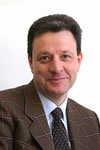Giuseppe Miccoli

My early experience in analysis and simulation came in the fields of machine noise and vibration measurement, complex system structural dynamic behaviour characterisation, component acoustic/functional optimisation, and analog /digital signal acquisition. Currently, I am in the position of Senior Researcher at the Institute for Agricultural and Earthmoving Machines (IMAMOTER), a position I have held since 1998.
In this role, my major research activities have been focused on noise and vibration active control, dynamic system theoretical/experimental characterisation, numerical simulation of complex structures/machine components, computational and experimental modal analysis, acoustic field characterisation and fluid/structure interaction analysis, and structure/machine component vibro-acoustic optimisation.
As a member of NAFEMS, and through being part of the Italian Steering Committee, I place great importance on promoting best practice and diffusion of numerical simulation and virtual design/prototyping technologies. The activities of the Italian Committee are carried out taking into account industrial reality and Italian training needs by means of courses, seminars, congress organisation, Italian translation/printing of specific text-books (Primers), and publication of the 'Analisi e Calcolo' (A&C) review- the NAFEMS' Italian language equivalent of BENCHmark. My involvement in the FENet project, allied with my participation in the Italian activities of NAFEMS, has given me a great appreciation of the analysis industry throughout Europe, and the importance of the NAFEMS organisation in this context.
Having been elected to the Council of NAFEMS, I hope to help extend the activities of NAFEMS throughout Europe and the rest of the world, bringing education and best practice to everyone involved in design, analysis and simulation. In the past, analysis was strictly the domain of the expert or specialist, often with complete departments in larger companies dedicated to the function. Today, low cost computing power and a wide range of analysis tools are readily available to the engineer. Facilities such as CAD geometry transfer, automatic 'meshing', in-built error checking, adaptive refinement and optimization tools, means that products have become much easier to use.
This has led to significant amounts of analysis being carried out by engineers throughout the product design cycle, and to the rapid uptake of analysis technology by smaller companies.
In particular, the multi-partnered collaborative design optimisation approach offers a method to achieve market dominance. To successfully implement significant time-to-market advantage the following important steps must be undertaken:
- foster an interdisciplinary design environment
- embrace design optimisation tools
- rely on computer simulated soft prototyping
- combine CAD-CAE-CAM
- be open to change: educate.
I believe that resting on policies and practices that have traditionally maintained market share, will be the downfall of organisations in the future. Technology will advance at an alarming pace in years to come and only those willing to adapt to the demands of this new marketplace can survive.
At the same time, companies are striving to reduce testing and rely, to an ever-greater extent, on the results of engineering analysis as the means of performance verification.
All of this places a high level of responsibility on the engineer or analyst.
It is widely recognised that in order to maintain a skilled workforce and to secure competitive advantage in a rapidly evolving marketplace, continual investment in training must take place. Many companies have empowered their employees with a responsibility to obtain suitable in-the-workplace knowledge.
One of the central aims of NAFEMS is to examine the educational and training needs for all those involved in engineering analysis and simulation, and to provide information to satisfy their needs. NAFEMS aims, on the one hand, to enable the less experienced analyst to produce reliable and accurate numerical predictions by taking the necessary steps to satisfy these requirements, and, on the other hand, to help the more experienced analyst to extend their area(s) of expertise by sharing their knowledge with the wider community.
Simulation and virtual prototyping are powerful tools in both the industrial and academic worlds. NAFEMS can be considered a landmark in support of both.



